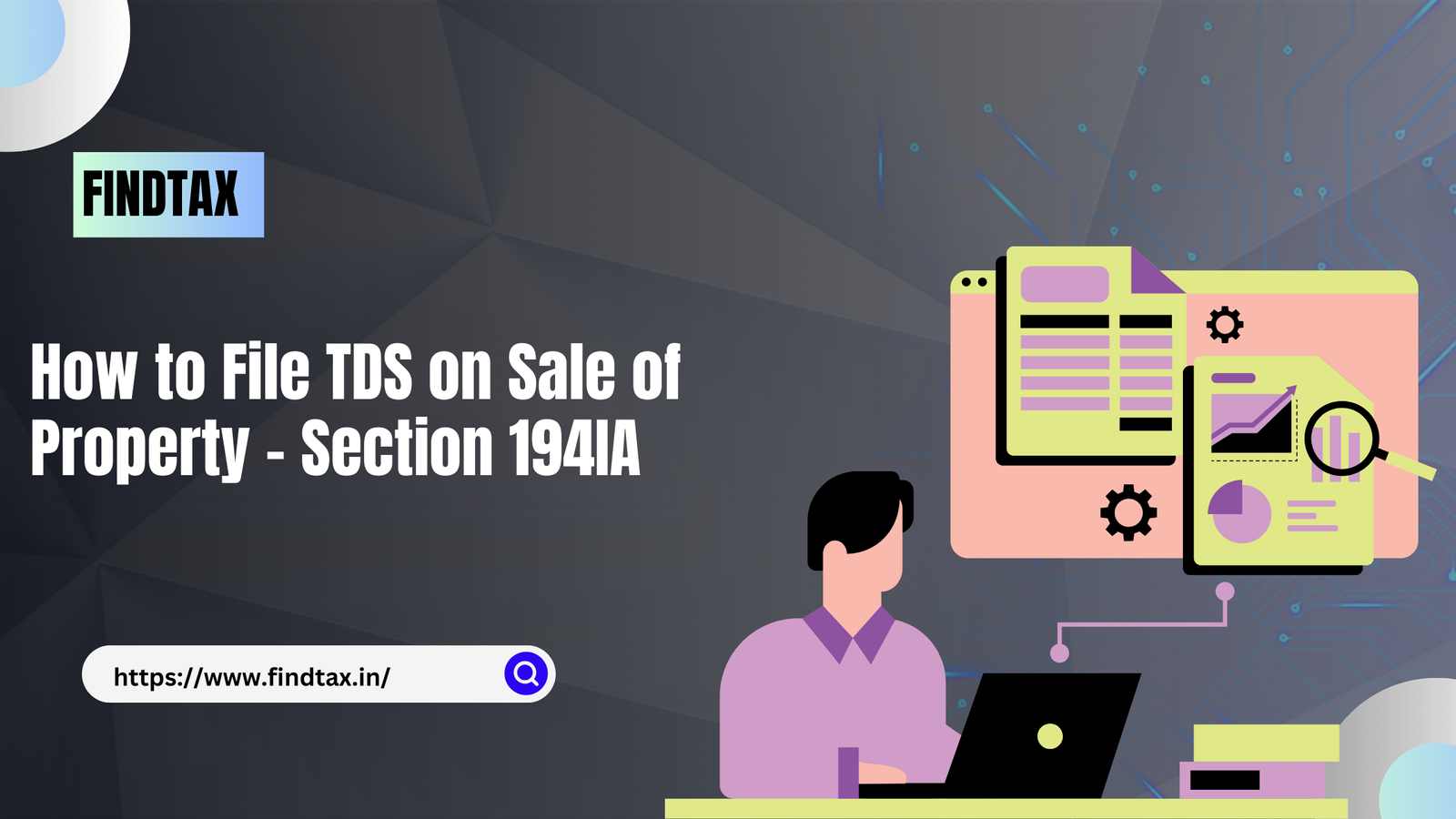

When buying or selling a property in India, taxes are a crucial aspect to consider. One such tax is the TDS (Tax Deducted at Source) applicable on property sales under Section 194-IA. This refers specifically to immovable property like land and buildings. The buyer must deduct tax at the time of purchasing the property.
Let’s explore the TDS rate on property sales under Section 194-IA, who is responsible for deducting it, and how to file TDS on property sales.
The below provisions are applicable to the Resident Seller, the buyer’s residential status is not relevant.
In case of NRI Seller TDS must be deducted u/s 195 at much higher rates.
Requirements of Section 194IA (Resident Seller)
When a buyer purchases immovable property (such as a building, part of a building, or any land other than agricultural land) costing more than Rs 50 lakhs, they must deduct tax at source (TDS) when paying the seller. This has been mandated by Section 194-IA of the Income Tax Act since 1st June 2013.
- The buyer must deduct TDS at 1% of the total sale amount. Note that the buyer, not the seller, is responsible for this deduction.
- TDS is required only if the total purchase value is Rs 50 lakh or more.
- If the payment is made in installments, TDS must be deducted on each installment paid.
- The term “Consideration for immovable property” includes all charges like club membership fees, car parking fees, electricity or water facility fees, maintenance fees, advance fees, or any other similar charges related to the property transfer. This applies to properties purchased on or after 1 September 2019.
- The TDS must be paid on the total purchase amount.
- The buyer does not need to obtain a TAN (Tax Deduction Account Number) to deposit TDS with the government. You can use your PAN.
- To deposit TDS, the buyer must obtain the seller’s PAN. Otherwise, TDS must be deducted at 20%.
- TDS is deducted at the time of payment (including installment payments) to the seller.
- The TDS must be paid using Form 26QB within 30 days from the end of the month in which TDS was deducted.
- After depositing TDS, the buyer must provide the TDS certificate in Form 16B to the seller, available about 10-15 days after the TDS deposit. The buyer must obtain Form 16B and issue it to the seller. You can find the procedure to generate and download Form 16B from TRACES here.
Steps to Pay TDS through Challan 26QB and Obtain Form 16
e-Payment through Challan 26QB (Online)
Step 1: Log in to your account on the Income Tax e-filing portal. Select e-File > click on e-Pay Tax from the dropdown.
Step 2: Click on ‘+ New Payment’.
Step 3: Click on the proceed button on the ‘26QB- TDS on Property’ tab.
Note: In the next few steps, you will have to add the following details:
- Add Buyer’s Details
- Add Seller’s Details
- Add Property Transferred Details
- Add Payment Details
Step 4: Add Buyer’s Details: Your details will be auto-filled, but you can change them if needed. Click ‘Continue’ after entering the details.
Step 5: Add Seller’s Details: Add the seller’s details like PAN and address.
Step 6: Add Property Details: Add property details like type, address, sale details, date of agreement, and value. The tax amount will be calculated automatically. Click ‘Continue’.
Step 7: Add Payment Details: Select the payment mode and complete the payment. A challan will be generated after payment.
Step 8: Register in TRACES
For first-time users, register on TRACES as a Tax payer with your PAN and the Challan details of the tax payment.
- Once registered, you can obtain the approved Form 16B (TDS certificate) and issue it to the seller.
- Check your Form 26AS seven days after payment. Your payment should reflect under “Details of Tax Deducted at Source on Sale of Immovable Property u/s 194(IA) [For Buyer of Property]”.
- Part F of the form provides details like TDS certificate number (generated by TRACES), the name and PAN of the deductee, transaction date and amount, acknowledgment number (same as the one on your Form 26QB), date of deposit, and TDS deposited.
Step 9: Download Form 16B
After your payment is reflected in Form 26AS, log in to TRACES. Go to the Download tab and click on “Form-16B (for the buyer)”.
Enter the PAN of the seller and acknowledgment number details of the property transaction and click “Proceed”.
Verify details and click “Submit a request”.
- After a few hours, your request will be processed. Go to the Downloads tab and select Requested Downloads from the drop-down menu.
- If the status of your Form 16B download request is ‘available‘, you can download it. If the status says ‘submitted‘, wait a few more hours and repeat the last step.
- Download the ‘.zip file’. The password to open the ‘.zip file’ is the date of birth of the deductor (format: DDMMYYYY). The form will be available inside the .zip file as a pdf. Print this out.
Notice for Non-filing Form 26QB
The income tax department receives an Annual Information Return (AIR) from the registrar/sub-registrar office regarding property transactions regularly. From this report, the department can identify if you have made a property transaction exceeding Rs.50 lakh.
If the buyer has not deducted tax at source at 1% of the transaction amount or not filed TDS within the specified time, the IT department will send a notice to the buyer.
Sample Notice Received by the Taxpayer
Subject: CPC (TDS) Notice
Follow-up: Pending Filing of 26QB Statement for Property Purchase in FY 2013-14
Date of Communication: 15/05/2017
Dear Buyer of Immovable Property,
PAN: XXXXX1234X,
Based on the Annual Information Return (AIR) received from the Registrar/Sub-registrar, it has come to our notice that you completed a transaction for the purchase of immovable property valued at over Rs. 50 lakhs during the Financial Year 2023-24.
However, it appears that you have not yet filed the TDS Statement in Form 26QB. We urge you to promptly address the following requirements regarding the filing of the TDS Statement in Form 26QB and the issuance of TDS Certificates in Form 16B, which can be downloaded from the TRACES portal.
Mandatory Filing of Form 26QB
According to the Finance Act of 2013, TDS must be deducted on the transfer of immovable property when the consideration equals or exceeds Rs. 50 lakhs.
Section 194IA of the Income Tax Act, 1961, along with Rules 30, 31, and 31A of the Income Tax Rules, states the following:
- For all such transactions effective from June 1, 2013, Tax @ 1% should be deducted by the purchaser of the property at the time of making payment of sale consideration.
- The deducted tax should be deposited into the Government Account using the e-tax payment option (Netbanking) or through any authorized bank branches.
- Any sum deducted under section 194-IA must be credited to the Central Government within seven days from the end of the month in which the deduction is made.
- PAN of both the seller and the purchaser must be provided in an online form (Form 26QB) to furnish information regarding the property transaction. This can be done on the website www.tin-nsdl.com (http://www.tin-nsdl.com/).
- A TDS certificate in Form 16B must be issued by the Buyer to the Seller, showing the taxes deducted and deposited into the Government Account.
- Form 16B can be downloaded after registering on the Centralized Processing Cell (TDS) website – www.tdscpc.gov.in (http://www.tdscpc.gov.in/).
Issuance of TDS Certificates in Form 16B downloaded from TRACES
All buyers are required to issue TDS certificates after generating and downloading them from the TRACES portal.
- The TDS Certificates downloaded only from the TRACES Portal will be valid.
Implications of Non/Late filing of TDS Statements
For Buyer of Property
- In case of default on account of non/late filing of Form 26QB, a fee will be levied under section 234E of the Act.
- The buyer will be liable to pay Rs. 200 for each day the failure continues.
- The buyer will also be liable for defaults of Late Deduction, Late Payment, and Interest thereon. A penalty under Section 271H may also be levied by the Assessing Officer.
For Seller of Property
- If Form 26QB is not filed or filed late, the seller will be unable to claim the TDS credit.
- The deducted tax must be deposited to the Government Account through the e-tax payment option (Netbanking) or any authorized bank branches. Any sum deducted under section 194-IA must be credited to the Central Government within seven days from the end of the month in which the deduction is made.
Penalties Applicable on Non-filing of Form 26QB
| Interest on: | Calculation |
| Not deducting TDS | 1% per month from the date on which you were supposed to deduct TDS until the day on which you actually deduct TDS. |
| Not depositing the TDS with the government | 1.5% per month from the date on which TDS is deducted to the date of payment to government. |
| Late filing fee: | Calculation |
| Late filing fee under section 234E @ Rs 200 per day | If you do not submit or delay in submitting Form 26QB, you may have to pay a fine under section 234E. The fine is Rs. 200 per day until you submit Form 26QB. This is in addition to the interest amount mentioned above. |
For any queries or filing TDS on Sale of Property – Contact Us or mail us at- info@findtax.in
FAQ’s
- Who is responsible for deducting TDS on the sale of the property?
The buyer of the property is liable to deduct TDS and deposit the same to the government.
- What if I don’t have seller’s PAN to deduct TDS on property sale?
The seller’s PAN is mandatory. If the PAN is not available, TDS is to be made at 20% of the purchase value. Additionally, the seller will not get the credit for the TDS amount.
- I am a buyer. Should I deduct TDS on the amount exceeding the property value of Rs 50 lakh or the entire amount I bought the property?
TDS has to be deducted by the buyer on the entire amount paid or credited to the seller if the amount exceeds Rs 50 lakh. For example, if a property is bought for Rs 70 lakh, TDS must be deducted on the entire amount, which is Rs 70 lakh, not just on the Rs 20 lakh that exceeds the Rs 50 lakh threshold.
- What is TDS on the sale of the property?
The Finance Bill 2013 proposed that the purchaser of an immovable property (other than rural agricultural land) worth Rs 50 lakh or more is required to deduct TDS at the rate of 1% from the consideration payable to a resident transferor.
- What is the time limit to pay TDS on a property?
TDS on immovable property transfers must be paid within 30 days after the end of the month in which the deduction is made.
- How do I claim TDS paid on sale of property?
To claim TDS paid on the sale of a property, can be claimed by the seller by following these steps:
- Ensure TDS Deduction: Confirm that the buyer has deducted the TDS and deposited it with the government.
- Obtain Form 16B: The buyer should provide you with Form 16B, which is the TDS certificate. You can download it from the TRACES portal after the buyer has deposited the TDS.
- Verify Form 26AS: Check your Form 26AS on the Income Tax e-filing portal to ensure that the TDS amount reflects correctly under Part F.
- Include in ITR: When filing your Income Tax Return (ITR), include the details of the TDS deducted under the relevant section.
- Claim Credit: In the ITR form, claim the TDS amount as a credit against your total tax liability for the financial year.
- File the Return: Complete and submit your ITR. Ensure that you have accurately filled in all details related to the TDS.
By following these steps, you can effectively claim the TDS paid on the sale of your property.

